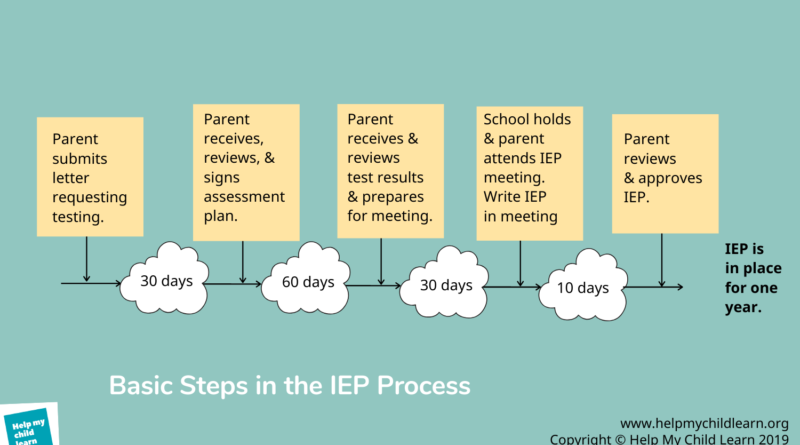Yes, but How do I Apply for an IEP?
“How do I apply for an IEP?” sounds like a simple question, but the answer is usually given in a complex fashion. In this post, we make the process simple. We describe the basic IEP process and walk you through it, so that you understand the steps and the function before diving into the details. Understanding the process before you start will save you time and energy.
This post contains the following sections, which guide you through a full overview and description of how to get an IEP.
- Applying for an IEP is a Legal Maneuver
- Your Child Must Qualify for an IEP
- What are the Steps in the IEP Process?
- Start by Writing and Submitting a Letter
- What Happens During the IEP Process?
- Educational Testing and Claiming Support
- Results of IEP Testing
- Getting Support for ADHD: 504 and More
- What Should You Know About an IEP Meeting?
- Who Is Involved?
- Educating Yourself About the IEP Process
- Hiring Professionals to Help
An IEP is an Independent Education Plan. It’s one of two legal support plans available to a child with learning disabilities. The IEP was established as part of a law called IDEA, the Individuals with Disabilities Act. IDEA specifies a few important things:
- It contains a Child Find mandate, that tells school districts that it’s their job to identify all children with learning disabilities.
- It guarantees the right to a free and appropriate public education (FAPE) for kids with disabilities, including learning and thinking differences.
Applying for an IEP is a Legal Maneuver
When you apply for an IEP, you are exercising your child’s legal rights. From the time you start, what is written down is very important.
The entire process of applying for an IEP is a legal and bureaucratic negotiation.
Just like in a court of law, you are building a logical argument for why your child should receive support. It works well to think of the IEP process as being a legal process, and to use your executive parenting skills to stay professional.
If your child qualifies for special education support, a team the school provides will set up a legal document that formally regulates how the school treats and teaches your child. If your child qualifies for an IEP, by law, you are part of the IEP team and attend all meetings.
Your Child Must Qualify for an IEP
13 types of disabilities can qualify for an IEP. As a child with learning disabilities, your child probably qualifies under the category of specific learning disability (SLD), which includes ability to read, write, to math, and focus. If you read the first few pages of this document, you’ll see a great description of SLD’s from a state special education agency. Specific learning disabilities make up almost 40% of all IEPs.
You don’t have to be sure that your child has an LD before you apply for an IEP. After all, they test your child as part of the process. But you do have to see a clear pattern of difficulty, and a pattern that shows that it’s very difficult for your child to learn. And you should gather information to demonstrate that difficulty, and to demonstrate that the teacher has tried different approaches.
To start, then, we recommend that if you think that your child has a LD, you
- Investigate what’s difficult for your child to do in school.
- Find evidence that (or describe how) your child is having trouble, and that the teacher has tried a couple of different methods to teach, the and then
- Write a letter, requesting an IEP, as we describe below. This starts a formal testing process process to see if your child is eligible for an IEP.
What are the Steps in the IEP Process?
Here are the five basic steps in the IEP process:
What Happens During the IEP Process?
- You write a letter, requesting testing for an IEP (as described above, this starts the process)
To start the IEP process, you write and submit a letter requesting LD testing. You can hand-deliver the letter to your school’s principal.
- The school district has 15 calendar days to consider your written request. If they refuse to test your child, they must send you a written notice, describing why. (See Disagreeing with the School and System if they refuse.)
- If the school agrees to test your child, they must develop an assessment plan and give it to you to review, within 15 more days.
By law, you can write a letter to the school principal, requesting that your child be tested for an LD at any time after noticing symptoms of trouble learning. A parent, teacher, or service provider can refer a child for assessment.
Requesting testing is separate from anything that the teacher is currently trying in the classroom. You don’t have to go through or ask permission from the teacher to request testing. Your request can be in addition to any efforts that the teacher or school are currently making.
In your letter, use the phrase: “I am writing to request that [your child’s name] be given a full psycho-educational evaluation, and be evaluated for services under the Child Find obligations of the Individuals with Disabilities Education Act (IDEA.)”
This post describes the letters further and contains four sample letters.
When the principal receives your letter requesting LD testing, the IEP legal process begins. From this point on, everything that the school does in response to you is dictated by the IDEA law, although states can set their own timeframes.
Because requesting testing is a legal argument, you should include evidence that your child has an LD in order for the school to agree to test your child. You should also include evidence that the teacher has tried several different approaches and they haven’t worked, and that your child’s learning problems impact their ability to learn.
- You receive, review, and sign the assessment plan: If the school district agrees to test your child and presents you with an assessment plan, you have 15 days to ask questions and sign it.Take a good look at the assessment plan. It’s important that the school does a comprehensive evaluation, and identifies specific points where your child’s learning process breaks down and how that impacts their classroom learning. Read the assessment plan to make sure that the school is testing everything that they should. If you took our Big Checklist to see what types of challenges your child has, make sure that school testing tests all of your child’s weak areas. (See the Educational Testing section, below. Also see The Whole-Child Diagnostic Approach.) Ask as many questions as you like. You can even set up a meeting with the testing professional to ask them more. Once you approve, sign the assessment plan. The school will not test unless you sign.
- Once you sign the plan, the school must complete testing and conclude whether or not your child has LD within 60 days.
- If the school determines that your child has a type of LD that is eligible for an IEP, the school schedules an IEP meeting to occur within 30 days.
- The school should send you a copy of the test results before the IEP meeting. The school must also explain the test results to you before the IEP meeting.
- If the school determines that your child doesn’t have an LD that lets them qualify for an IEP, they will sometimes offer a 504 instead. See Claiming 504 Support.)
- You receive and review test results before the IEP meeting: If your child qualifies for an IEP, you are entitled to have the person who administered the test explain the test results to you before the IEP meeting. If your child is turned down for an IEP, or if the test results don’t correctly reflect your child’s challenges, then you should request an Independent Educational Evaluation, as described in “Disagreeing With the School and System,” below. )
- You research and prepare to be a participant in the IEP meeting: Educate yourself about the IEP process and reach out for support. If you see problems that testing hasn’t identified, bring them to the meeting. When the team sets up a meeting, they will establish education goals and objectives for your child, for this coming year. Write down all of your input for the IEP so that it will be in the record.
The school holds an IEP meeting, in which the IEP is written by an IEP team. You are part of the IEP team, and participate in all meetings, discussion, and decisions. The meeting must contain people who can make decisions about how to support your child.
Educational Testing and Claiming Support
Children with LD typically have multiple weaknesses that overlap, so we suggest that you request a full educational evaluation, instead of just testing for one skill.
If the school district gives your child a full educational examination, they test up to seven areas of development:
- Language
- Visual and spatial thinking (also called nonverbal processing)
- Attention and self-regulation
- Memory
- Fine and gross motor skills
- Social and emotional abilities
- Executive function
Parents caution that just requesting a full educational evaluation doesn’t guarantee that your child will get one. Make sure that you compare the test plan to the list above, and ask questions. You should request assistive technology testing at the same time. Your child might need assistive technology includes keyboards, iPads, and other tools that compensate for disabilities.
If you want the school district to add more types of testing to their testing plan, you might say “My child doesn’t remember how to add, no matter how many times it is explained, so I want tests that specifically test his ability to understand numbers, to memorize things, and to write numbers.” Being respectful, having good reasons behind your requests, and writing everything down are good ways to get what you want.
Some parents report that that in addition to requesting a full educational evaluation and an assistive technology test, they had to specify OT diagnostic testing, speech and auditory, and dyslexia testing. It’s a good idea to write down what tests you want, and email them to the person in charge of testing. A paper trail is good.
In general, you should request that a pediatric occupational therapist be the person giving your child an evaluation. A pediatric OT understands the developmental steps, and will give a broader view than an OT who doesn’t focus on pediatrics.
Results of IEP Testing
The school district uses the results of your child’s testing to determine if your child has an LD, and if your child qualifies for an IEP.
An entire industry of legal fighting and arguing exists over the question of whether or not specific children qualify for IEPs. Just having a learning disability doesn’t qualify a child for an IEP. Your child must qualify for two things in order to receive an IEP: Testing must conclude that your child is diagnosed with one of the 13 disabilities that are supported by IDEA.[xvii] Testing must also conclude that the disability adversely affects educational performance, and because of that, your child is unable to receive proper education.
Most of the learning differences that we mention in this book are covered by Specific Learning Differences category within IDEA.
If you are told that your child does not qualify, and you disagree, you can request outside testing as described in “IEP Disagreements,” below. If your child is turned down for an IEP and you don’t want to disagree with the results of testing, you can request a 504 plan. The qualifications for getting a 504 are substantially easier than for getting an IEP. See “Qualifying for a 504,” below.
Getting Support for ADHD: 504 and More
Many people think that their ADHD child is only eligible for support under Section 504, but this isn’t true. IDEA provides support for ADHD children under the “other health impairment” category, the specific learning disability category, or the emotional disturbance category.[xix] IDEA qualification means that ADHD children can be covered by an IEP.
What Should You Know About an IEP Meeting?
You should receive your child’s test results and have them explained to you before the IEP meeting. Remember: all support is tied to test results. Also before the IEP meeting, both you and the district should research what will go into the IEP.
When you attend an IEP meeting, the actions are scripted. You and the team show up, you need to do a certain number of things and produce certain output. There are thousands of websites and hundreds of books and pamphlets telling you how to attend an IEP meeting and what to do.
When you and the team develop an IEP, it will include the following:
- Your child’s present levels of achievement and performance. Make sure that important information is in here. Don’t let anything get dropped.
- A statement of measurable goals. This is important because these are legal goals. The school must meet them
- Appropriate, measurable goals and benchmarks. Any goals in the IEP should be written in measurable language (improves 30% or increases to the beginning of third grade level.)
- Specification of scientifically-based instruction, provided by a qualified individual (one with a special education teaching credential.
Consumers are encouraged to set up a SMART IEP. The SMART acronym refers to IEP goals, which should be:
Specific,
Measurable,
using Action words,
Realistic and relevant, and
Time-limited.
For examples of SMART IEP goals, see these IEP Goal banks, which have all sorts of examples.
Here are the top tips from parents about succeeding in an IEP meeting:
- Follow your gut and don’t back down. You know your child best.
- Represent your child’s needs. When you attend an IEP meeting, you should bring with you all of the information that you have about your child, including his strengths, what motivates him, and what’s the most effective way to teach him. Chapter 4, “Understanding Your Child” can help you to develop that information. Make sure that you have gone over test results with the people who tested, and that you have fully researched what all of the test results mean.
- Come to the table with ideas or a proposal and ask for what you want. Don’t sit passively. Before the meeting, do your homework, talking with parents and experts to find out what options might be available for your child.
- Know roughly what the school district is able to do for your child. This is more homework. Become a detective. Find out how the school supports other children, and try to find names of good teachers and special education teachers in your district.
- Consider bringing a friend or professional. Many parents bring a good friend or someone who really knows the process. This is allowed.
- Learn to aggressively request support technology. If your child has trouble with math, handwriting, and reading, tools can absolutely change his world. Get those tools into the IEP (or 504 accommodations), and make sure that teachers are trained in how to work with a child who uses those tools. For memory issues, consider letting your child take pictures of the white board. The Fine Until Kindergarten website has lists of support technology.
- Request 24 hours in advance that you be able to tape record the meeting. On the day of the meeting, keep it light. Make a joke about poor memory and thank them for letting you record. Anything to keep things friendly, while at the same time exercising your legal rights.
- Don’t sign anything the day of the meeting. We all need to think things over.
- You can always call another meeting! Parents report calling another meeting if:
- A person who can make decisions about your child’s education isn’t present at the meeting (they must attend, by law).
- Anybody who should be at the meeting missing.
- The IEP isn’t completed at the meeting.
- Parents cannot come to agreement with the district at the meeting.
In addition, parents report that the way in which schools describe your child in these meetings is relentlessly negative—be prepared for it.
As Amazon associates, we earn a small commission if you click on an embedded Amazon link in our text.
If you are brand new to getting an IEP or 504, we recommend the Fine Until Kindergarten: A Parent’s First Guide to Learning Disabilities book for the same level introduction to an IEP that you see in this post. Very simple. Then we recommend From Emotions to Advocacy, by Pam and Pete Wright, which is accessible, and has great advice. The FetaWeb website was created to support the Emotion to Advocacy book.
The Understood website also has a description of the IEP process.
And finally, the Wrightslaw website contains many articles and tips for how to put together an IEP, but many parents find it overwhelming.
Who Is Involved?
These are the primary players as you negotiate for your child to receive support in the educational system.
Your child’s teacher is the gateway to and provider of day-to-day support and teaching. She is your first point of contact, and she will be working on methods to teach your child in her class. You will work with her to get your child tested initially. You will often work through several steps and meetings with your teacher before your child is referred for diagnosis and support. Your child’s teacher will attend any meetings that are held during the process of claiming support.
Reading specialists, occupational therapists, speech therapists, and additional credentialed professionals may work with your child. You are always welcome to ask for qualifications. For more information on what qualifications should be, see Appendix D, “Types of Doctors and Specialists.”
The school counselor may or may not be involved in helping your child settle in and succeed in the school. The counselor is often consulted for behavioral problems or if a child shows signs of emotional distress. Unfortunately, some schools no longer have counselors because of budget constraints.
The school psychologist is a professional with a M.A. in school psychology. Often he or she serves more than one school so is only available occasionally. The school psychologist is responsible for testing, data collection, academic or learning interventions, and behavioral interventions. The school psychologist should be available for consultation and should usually attend support meetings.
The Principal is usually who you go to if you are unhappy with how the teacher or school is handling your child’s case. If the teacher doesn’t recommend your child for testing, you can write a letter requesting testing to your principal, as described below.
Your district’s Special Education Coordinator or Director (sometimes called special services) is responsible for special education support throughout the district. If you need to escalate an issue above a principal, you can first speak with the Special Education Coordinator, and then the Superintendent of Education for your school district.
Educating Yourself About the IEP Process
Other things to know about applying for an IEP:
- How to work with your child’s teacher to support learning and collect information.
- What’s the difference between an IEP, a 504, and the RTI program?
- How to investigate your child’s learning challenges and describe/prove them in a way that your child qualifies for an IEP.
There are many places to find help. Although the laws setting up special education are federal, each state can have different dates and rules for claiming support. It’s a good idea to start by reading simple instructions that have been written for parents in your state. Just Google™ IEP resources for [put the name of your state here].
The IEP process is a complex, legal process, but like many legal processes, it seems a lot more complex than it needs to be.
Any legal process needs to lay out all of the rules, not just for the law’s basic situation—but for any situation that could ever happen. That’s a lot of information! Furthermore, many of the people who explain IEP laws to parents don’t make it as simple as they could. For this reason, I suggest that you learn about the IEP process from three sources, at the same time:
Other Parents The most important thing to know in any legal situation is: what should you want, and how do you get it, in the most effective fashion. If you have the opportunity, ask a parent! Parents can tell you what you need to know, who the resources are, and what works. Furthermore, parents can tell you how their situation was handled.
Even if you’re an introvert, ask for help in finding parents who have been through this process. Ask the president of the PTA, ask local doctors, ask the counselor, ask teachers. Ask on the internet. (See also “The Power of Community: Joining Support Groups,” in Chapter 3.)
There is no set way for parents to find one another. This means that it’s hard for parents to share information and be effective. One of our goals at Help My Child Learn is to fix this. Please sign up for our email list—and we will share information as we gather and distribute it.
Finally, remember that you can either hire an advocate, as described in “Hiring Professionals to Help,” below, or you can just ask a friend to attend the IEP meeting with you. Parents who have been through the process are often very happy to reach out and help other families. Communication is key to success.
Hiring Professionals to Help
Some parents hire consultants, or advocates who help them get their information together and request an IEP. The type of professionals who provide this type of service are sometimes IEP Advocates. Some Educational Consultants are qualified to perform advocacy services, and some Attorneys at Law specialize in educational law and IEPs. Although you can use the internet to find this type of professional, it’s much better to get a referral from another parent, since quality can vary.
If you are going to hire an advocate, it’s perfectly acceptable to ask for (and check) parent references. You can also ask specifically for a reference who has a case similar to yours. It’s also a good idea to compare prices and negotiate cost.
It’s best to think about what you want for your child before you interview or hire a professional. You can get this idea from doing a bit of reading, and from talking with other parents. Sometimes a teacher will give you some pointers as well (off the record, usually.)
You can then approach an advocate or two, explain your child’s learning profile and educational needs, and ask them what types of services they provide to help your child get that support. And then you can compare what two (or more) different advocates tell you. Be cautious and well-informed when you hire professionals to help. And remember: you can take anyone you wish to an IEP meeting. It can be your sister or a neighbor. It doesn’t have to be a paid professional.
For More Information
For more information in this website, see:
- Comparison of LD Support Program—what are the benefits and disadvantages?
- What does the letter look like when I request an IEP?
- How do I apply for a 504?
- How do you disagree with the school while applying for an IEP?
Here are some of our favorite outside resources.
As Amazon Associates, we earn when you purchase qualifying purchases from Amazon.
- One of the best resources available to help you through the IEP process is the book From Emotion to Advocacy, written by husband-wife lawyers Peter Wright and Pamela Wright. Pete Wright was diagnosed in second grade with learning disorders, including dyslexia, dysgraphia, and ADHD. His parents got intensive Orton-Gillingham remediation for him, and he studied both psychology and law.
- The Wrights have also written All About IEPs and All About Tests and Assessments.
- They created the FetaWeb website for the Emotion to Advocacy book and they also created the Wrightslaw website.
Websites While websites are a wonderful resource, it’s good to remember that each state can have their own legal variations, so it’s good to find out what your state requires. To see resources that, by law, your state is required to provide, simply type the following into your internet search engine: State name IEP help. For example: Minnesota IEP help will return a list of help resources about getting an IEP in Minnesota.
- Understood.org is a consortium of LD support organizations, which delivers LD information to parents. They have a good overview of the process of getting your child an IEP, and a section that answers many questions.
- The Wrightslaw website. can be extremely intimidating to the first-time user, but if you get into a prolonged legal battle with your district, you will be very happy for it. The From Emotion to Advocacy book is one that we recommend for everyone trying to get an IEP. It’s clear, logical, and is full of wise advice for handling situations with teachers and schools. Their associated Fetaweb website is full of advice as well.
- There are many other wonderful websites that contain information about IEPs and helping your child. This website lists parent training centers for every state. You can also search for [your state name] IEP Advice to find state-specific information. For example, here’s a California Department of Education website that we get if we search for California IEP Advice.










Pingback:What's the Difference Between a 504, an IEP, and a RTI - Help My Child Learn
Pingback:How do I Write a Letter to Request an IEP - and More - Help My Child Learn
Pingback:What Should I Know about Laws That Protect Learning with the 504 and IEP - Help My Child Learn
Pingback:Managing Teacher Relationships: An Overview - Help My Child Learn
Pingback:What to do if Your LD Child is Bullied - Help My Child Learn
Pingback:The World of LD Parenting - Help My Child Learn
Pingback:What's inside of an Executive Function Disorder? - Help My Child Learn
Pingback:Overview of Disagreements and Problems with an IEP - Help My Child Learn
Pingback:What Can an LD Diagnosis Do (or Not Do) For Your Child? - Help My Child Learn
Pingback:The First Thing to Do As a LD Parent: Buy a Binder! - Help My Child Learn
Pingback:Helping Your LD Child Succeed with Teachers and School - Help My Child Learn